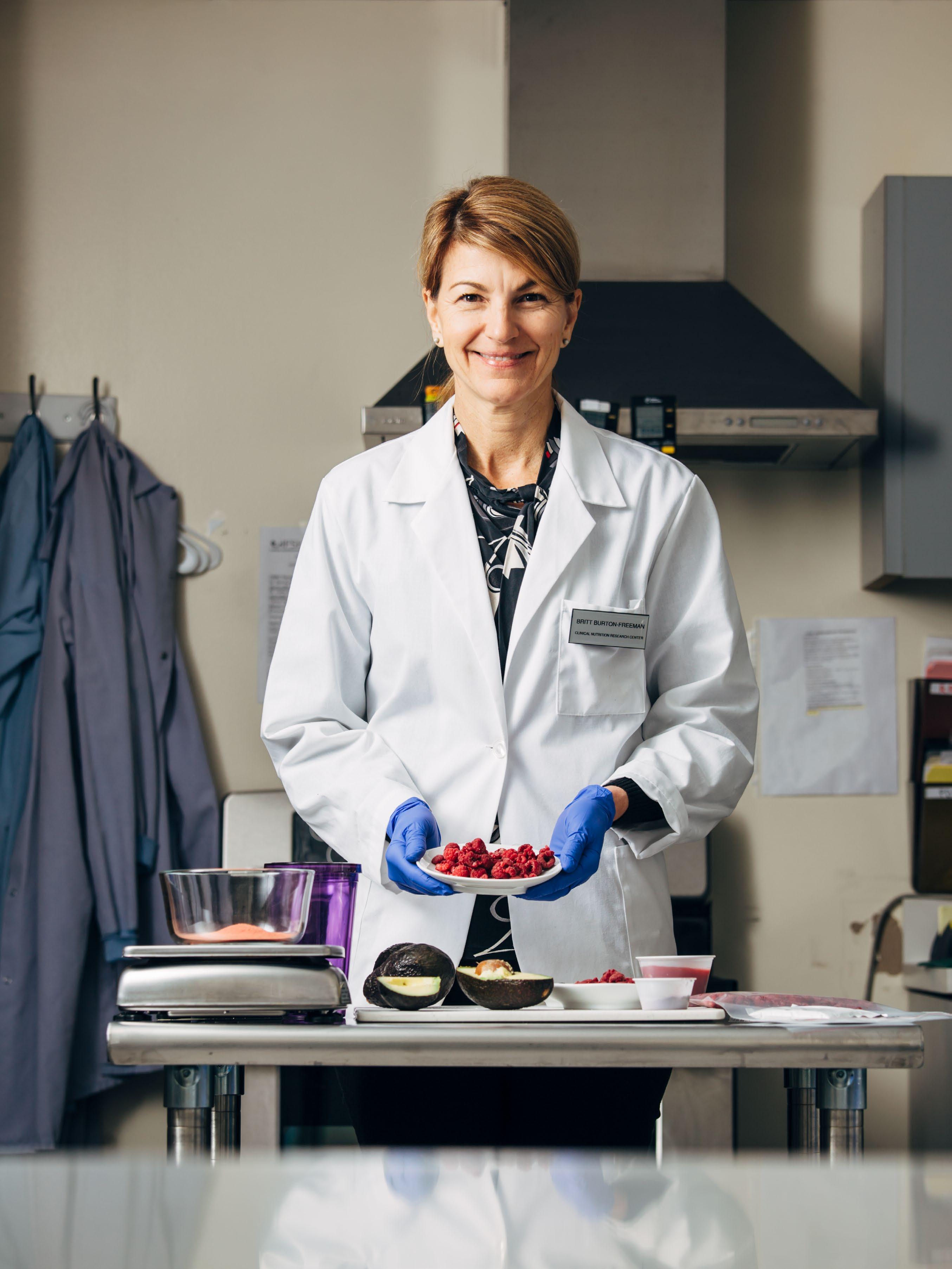
2022 Illinois Tech Research
Sustainability’s
Using
Building
Software Update A Global Approach to Cybersecurity Circling the Solution to Food Waste
Technology to Hone Dietary Intervention
In the area of health and nutrition alone, cross-disciplinary teams are advancing on many fronts. We are learning how to develop personalized nutrition plans based on biometric data and artificial intelligence. We are studying how racial segregation and the resulting lack of a healthy food supply harms the health of African Americans. We are learning how technology is influencing farming. We are finding ways to reduce food waste. We are running clinical studies on an artificial vision system. We are running large-scale epigenetic simulations to inform the treatment of disorders and diseases. We are developing medical imaging tools to help surgeons remove cancerous tissue while leaving healthy tissue. We are developing new oral antibiotics to replace obsolete ones, and we are mobilizing how E.coli can be used to kill harmful bacteria when antibiotics don’t work. We are using AI to diagnose diabetes.
Moreover, our researchers are addressing needs in safety and security, energy and transportation—technology that serves humans well, and helps create a more diverse, inclusive, and equitable society.
Our research covers the spectrum from fundamental to applied. I hope that you will enjoy discovering what we are doing in this year’s Illinois Tech Research magazine.
If you have questions about the research featured here, please contact the faculty to learn more. You may also contact me at hickernell@iit.edu.
Sincerely,
Fred Hickernell Vice Provost for Research Professor of Applied Mathematics
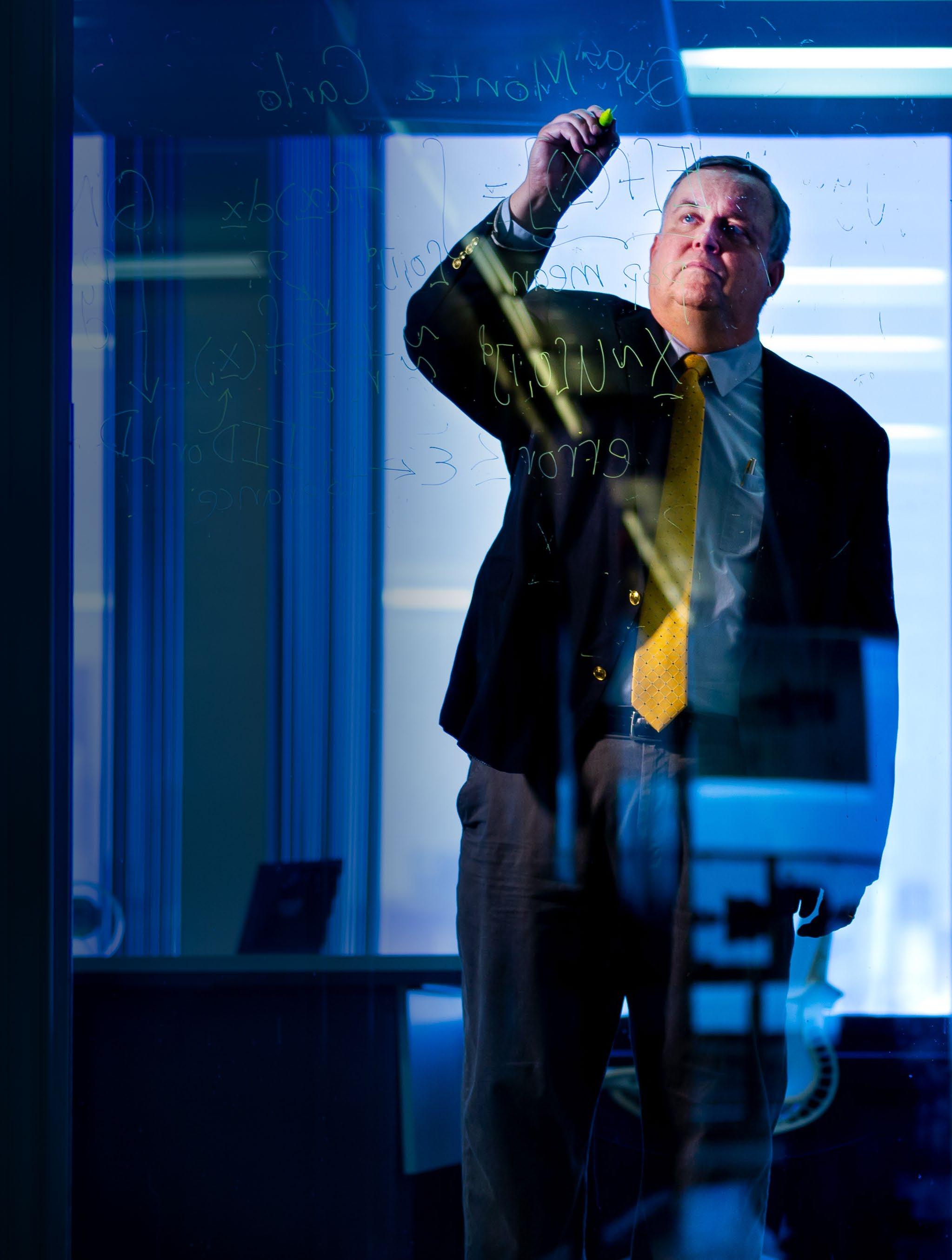 Illinois Tech faculty, students, and staff are addressing a variety of societal needs.
Illinois Tech faculty, students, and staff are addressing a variety of societal needs.
Illinois Tech
Diet, Deconstructed
Illinois Tech is part of a nationwide nutrition study that will combine biometric data with AI and machine learning technologies to advance the development of personalized nutrition plans.
Model of Stability
Two applied mathematics professors are helping to develop stable surrogate models that will be able to make long-term predictions that could benefit a multitude of research areas.

On the Cover Britt Burton-Freeman, a professor of food science and nutrition, is leading Illinois Tech’s involvement in a nationwide study that blends nutrition and tech.


Expanding Security
Assistant Professor Maurice Dawson used his fourth Fulbright award to conduct research in the African nation of Botswana, exploring its cybersecurity issues and their impact globally.

An Unlikely Ally
Mixed Messages
Associate professors Nikki Legate and Arlen Moller collaborated on a study that engaged more than 27,000 people to gain insights into the effectiveness of social distancing messaging.
In an effort to attack dormant bacteria that are resistant to antibiotics and can cause chronic infections, Associate Professor Seok Hoon Hong is turning to an improbable source: E.coli.
Engine Ingenuity
In pursuit of sustainability, Associate Professor Carrie Hall has created a new computer model that can enable diesel engines to run on alternative fuels with just a software update.
A Novel Approach
A team led by Associate Professor Oscar Juárez is working to create a new oral antibiotic to treat cholera, as well as certain sexually transmitted diseases and other infectious diseases.

Recipe for Success
It’s estimated that up to 40 percent of food produced in the United States is never eaten, and Associate Professor Weslynne Ashton is looking to create solutions to that problem through two new projects.
Illinois Tech Research is published annually by the Office of Marketing and Communications and the Office of Research.
ADA Statement
Illinois Institute of Technology provides qualified individuals with disabilities reasonable accommodations to participate in university activities, programs, and services. Such individuals with disabilities requiring an accommodation should call the activity, program, or service director.
For further information about Illinois Tech’s resources, contact the Illinois Tech Center for Disability Resources at disabilities@iit.edu.
2022
Features Briefs Research 24 28 30 32 14 18 16 20 3 Extreme Storms’ Impact 4 Computers Designing Engines 5 ‘Work Calling’ 6 Algorithmic News Bias 7 Machine Learning in Finance 8 Smarter Robotics Systems 8 Socially Conscious Design 9 Wireless Artificial Vision System 10 Decoding Genetics
Is Technology the Best Policy?
Having grown up in a small farming community in Minnesota, Monika Sziron (THUM Ph.D. Candidate) has a personal connection to agriculture. Her interest now lies in better understanding how artificial intelligence is affecting farming and agriculture, and how farmers are reacting to that. “I’ve always been interested in how technology

changes the human experience. Technology and farming have this very complex history,” Sziron says. “Depending on what tools we were using changes how farming is done, and it also changes the culture.”
—Tad
2 Illinois Tech Research
TECHNOLOGY
Vezner
See video
“ I’ve always been interested in how technology changes the human experience.”
Illinois Tech Research 2022 2
—Monika Sziron (THUM Ph.D. Candidate)
Two Similar Extreme Storms, Two Very Different Socioeconomic Impacts
A study of the economic impacts of Hurricane Katrina and Superstorm Sandy could lead to more equitable climate resilience planning for cities anticipating severe weather events going forward.

In “Structural Path Analysis of Extreme Weather Events: An Application to Hurricane Katrina and Superstorm Sandy,” Illinois Institute of Technology Associate Professor of Social Science Yuri Mansury examines the impact of the two storms on households’ income and properties, looking at which populations saw the most economic harm from the storms.
“Preexisting inequality does matter—how economic characteristics like wealth and income were distributed,” Mansury says. “In New York, it is primarily about the financial sector—Wall Street, legal, advertising—[because] it was primarily downtown Manhattan that was flooded [when Superstorm Sandy hit]. It was the high-income population that was affected the most. In New Orleans, it’s a place that is heavily dependent on mining and the oil industry.
The low-income households in New Orleans are very dependent on mining activity, and they were the ones that were affected the most by [Hurricane] Katrina.”
Mansury and his colleagues used geographic information systems to look at patterns of economic activity that existed in New Orleans and New York in the areas that ended up underwater. Their research incorporated satellite images of flooding, business locations, and how much revenue those businesses generated before and after the storms.
The team is now planning a follow-up study that explore how quickly residents and households experience the economic impact of natural disasters.
“We want to be able to anticipate and come up with a mitigation plan that takes into account the speed through which the effect is transmitted to vulnerable households,” Mansury says.
—Linsey Maughan
3
FUTURES $ $ $ $ $ $ $ $ $ $
URBAN
Getting Granular
The properties of all materials shift on a microstructural level as they are exposed to outside forces, but developing a model that accurately predicts how these properties shift has been elusive.
Chun Liu, professor and chair of the Department of Applied Mathematics at Illinois Institute of Technology, has joined a team of researchers that aims to accomplish this task through a combination of mathematics and data analytics.

The level of a given material’s functionality changes over time as its properties change. All materials are composed of a lattice structure of monocrystalline grains, with each grain fixed by boundaries. These boundaries are altered in a process called grain growth, and how that grain growth occurs affects the functionality of the material.
“Being able to predict grain growth is one of the crown jewels in
Can Computers Design Electric Motors?
Ian Brown’s research is still in its infancy, but Ford Motor Company and the United States Department of Energy have already decided to help fund a project that could improve the future of electric motors and generators.
Brown, associate professor of electrical and computer engineering, is working to remove humans from time-consuming steps in designing electric machines. Currently, after human lists the objectives a new engine must meet, a process begins where designers pick a template, select ideal materials, and make it all fit together.

Mathematical tools created by Brown skip the time-consuming process and find an ideal combination to elicit the best performance
materials science,” Liu says. “This will help both predict the changes in functionality of materials and create new materials.”
By employing state-of-the-art mathematical modeling and analysis together with problem-specific analysis, Liu says the research team should be able to develop a computational platform that can accurately predict grain growth, especially if it can collaborate with other materials scientists. The team was awarded a $1.8 million National Science Foundation grant from the Designing Materials to Revolutionize and Engineer our Future program, with Liu receiving about $300,000 for “Microstructure by Design: Integrating Grain Growth Experiments, Data Analytics, Simulation, and Theory.” —Casey Moffitt
Ask Illinois Tech’s Ian Brown
from electric machines. “We’re letting the optimizer come up with clever new ways to design things. It is an aide to human ingenuity,” Brown says. —Simon Morrow
4 Illinois Tech Research
the optimizer?
COMPUTATION AND DATA ENGINEERING What is
4 Illinois Tech Research 2022
HEALTH AND WELLNESS
Called to Work
The COVID-19 pandemic placed enormous demands and stress on hospitals worldwide, especially when the transmission of the disease spiked, overrunning the capacity of hospital staff to provide care.
Associate Professor of Management Smriti Anand at Illinois Institute of Technology’s Stuart School of Business is co-author of a research paper that gives insight into the contributions made during the pandemic by an often unheralded group of hospital workers, and what managers can learn from this crisis.
“You Can Stay Home, but We Can’t: Invisible ‘Dirty’ Work as Calling Amid COVID-19 Pandemic,” published in the Journal of Vocational Behavior, explores the motivations behind the strong service orientation, or work calling, among frontline janitorial workers at a large hospital in India that was designated for treating COVID-19 patients.
The paper has been selected by the World Health Organization for inclusion in the WHO COVID-19 Research Database.
Anand’s research colleagues, who developed the survey project in coordination with the Indian government’s COVID-19 response task force, are faculty at the Indian Institute of Management Rohtak: Professor Dheeraj P. Sharma, director of IIMR, Associate Professor Koustab Ghosh, and Visiting Assistant Professor Madhurima Mishra.
According to Anand, the custodial workers studied were not only putting their own health at risk at their jobs, they also were subject to suspicion, discrimination, and mistreatment outside of work hours by local residents who feared they were carriers of COVID-19. Still, the janitors persevered in their work.
“We found that these workers, because of the dramatic situation [caused by the pandemic], felt they were saviors,” Anand says. “And they were, because how would the hospitals have run if the janitors went on a strike?” —Scott Lewis
5
Bias in the Bubble
Algorithms may give you personalized web search results and movie suggestions, but when they streamline your social media posts and news feeds, they could create a self-fulfilling feedback loop.
Researchers at Illinois Institute of Technology found that algorithms recommending news stories can create filter bubbles, exposing readers to articles that reinforce biases and block outside opinions.
After studying thousands of news articles and sources, Mustafa Bilgic, associate professor of computer science at Illinois Tech, and Matthew Shapiro, professor of
political science, published “The Interaction Between Political Typology and Filter Bubbles in News Filter Algorithms” in collaboration with colleagues.
“If the algorithm shows you only the
news that it thinks you are going to like, to maximize its chances that you will click on it, you may not know that these other perspectives and these other news even exist,” Bilgic says. —Casey Moffitt
Model Transportation
Hemanshu Kaul, associate professor of applied mathematics at Illinois Institute of Technology, and Adam Rumpf (Ph.D. AMAT ’20) examined Chicago Transit Authority bus routes in order to develop a mathematical model with an ethical element, which will increase access to health care centers while minimizing the impact to current riders in a paper titled “A Public Transit Network Optimization Model for Equitable Access to Social Services.”
“Are our mathematical, scientific, and social assumptions creating an inbuilt bias that cannot be overcome even if we do everything else perfectly to avoid any bias in our algorithmic computations, data collection and analysis, and in the real-world recommendations?” Kaul says. “This question led me to think how I can make a meaningful contribution in this context by studying a widely used
mathematical model and the ethical impact of the decisions made using it.”
Kaul and Rumpf examined the access that Chicago’s public transportation system provides to health care centers from each of the city’s 77 neighborhoods. They found access inequities in many far South Side and far North Side neighborhoods and developed a model that uses existing bus routes, as well as creating express bus routes, to even out this access across the city.
The result shows that people living in neighborhoods with minimal access to health care centers with the current bus routes increased access by 45.3 percent, while those with maximum access decreased by just 3.7 percent. —Casey Moffitt
6 Illinois Tech Research COMPUTATION AND DATA
Illinois Tech Research 2022
HEALTH AND WELLNESS
Reworking the Risk
Five years ago Matthew Dixon, assistant professor of applied mathematics at Illinois Institute of Technology, took a gamble and directed his research almost exclusively to machine learning in finance.

That decision is already starting to pay off: Dixon was named in February as a recipient of the Buy-Side Quant of the Year award by wInvestments’ Artificial Intelligence Asset Management Center of Excellence, earned the award for their joint research using machine learning techniques in optimizing retirement plans and other goal-based wealth management problems.
Dixon and Halperin developed “G-learning,” a probabilistic extension of Q-learning, which is a common reinforcement-learning algorithm.
“We both had misgivings about deep Q-learning for many financial applications, and [we] had faced quite a bit of pushback making our views public on this, which motivated us to pursue it further,” Dixon says.
Stock prices are very noisy, and fitting deep neural networks to noisy data is like reading too much into the shape of clouds, Dixon says. Dixon and Halperin treat the noise as the weakest link and concentrate on addressing that issue rather than putting emphasis on a deep neural network approximation. Since deep networks aren’t needed, the simpler approximators are much faster to run. The results can help investors decide how to invest and how quickly those savings should be spent.
Dixon says the research could have far-reaching applications in financial planning—from when to buy a house, budgeting for college tuition, choosing life insurance plans, and tax planning.
—Casey Moffitt
7 TECHNOLOGY
G->Q -> -> -> -> ->
Creating Smarter Methods of Robotics Systems
A passion for developing artificial intelligence led mechanical engineer student Esteban Lopez (ME ’20, M.S. MAE Candidate) to an internship with Boeing, where he learned a well-rounded skillset is more important than a prowess in coding. —Thaddeus Mast

A Socially Conscious Approach to Design
An architecture project designed and built by Illinois Institute of Technology students is the recipient of the American Institute of Architects Chicago Chapter’s first Roberta Feldman Architecture for Social Justice Award Citation of Merit. The award, established in 2020, recognizes projects that are “guided by the conviction that access to high-quality architecture is not a privilege, [but] a human right.”
Designed in the spring and constructed in summer 2016 by College of Architecture students, the Antihuala Community Center was the product of a Design/Build studio led by Associate Professor Frank Flury. Situated next to a lake in the remote Chilean town of Antihuala, the community center was built on land owned by ARAUCO, a global manufacturer of forest products, in an effort to mediate the relationship between the corporation and the neighboring communities. According to Flury, the permission to construct a public pavilion on the corporately owned land was the first of its kind in the region.
Inspired by the surrounding mountains and constructed from local timber, the steep, step-sided structure’s design recalls ancient Latin American pyramids. After the project was designed on the

8 Illinois Tech Research COMPUTATION AND DATA
Illinois Tech campus, Flury and his students—along with members of the local community—spent two months in Chile building the structure. Today, the center serves as a recreational facility and hosts meetings, concerts, and other gatherings. —Andrew Connor
URBAN FUTURES
“
As we create and design more sophisticated robotic systems, we need smarter methods in order to get these complicated systems to complete complicated tasks.”
Illinois Tech Research 2022
—Esteban Lopez (ME ’20, M.S. MAE ’22)
See video
A Brain Has Been Successfully Implanted with a Wireless Artificial Vision System

While there is currently no cure for blindness, a first-of-its-kind artificial vision system has undergone its first successful implantation, bringing with it the potential to restore partial vision to people who have lost their sight.
The Intracortical Visual Prosthesis (ICVP), an implant that bypasses the retina and optic nerves to connect directly to the brain’s visual cortex, has been successfully implanted in the study’s first participant, at Rush University Medical Center. It is the first intracortical visual implant to use a group of fully-implanted, miniaturized wireless stimulators to explore whether individuals with blindness can utilize the artificial vision provided by this approach.
The ICVP system was developed by a multi-institutional team led by Philip R. Troyk—executive director of the Pritzker Institute of Biomedical Science and Engineering at Illinois Institute of Technology, professor of biomedical engineering, and Robert A. Pritzker Endowed Chair in Engineering—and represents the culmination of nearly three decades of Illinois Tech research dedicated to ultimately providing artificial sight to those with blindness due to eye disease or trauma.
“This is an incredibly exciting moment, not just for the field of biomedical engineering, but more importantly for people with blindness and their loved ones around the world,” says Troyk. —Simon Morrow
9
ENGINEERING
Practical Solutions
A team of student researchers guided by Kyle Hale, assistant professor of computer science at Illinois Institute of Technology, earned the Gilles Muller Best Artifact Award at the Euro pean Conference on Computer Systems (EuroSys ’22) for its work on a software framework that enables easy isolation of functions within applications.
“Isolating Functions at the Hardware Limit with Virtines” questions the idea that hardware virtualization is slow and impractical. The Virtines software approach does not require the use of specialized hardware and applies easy-to-use language extensions to make hardware virtualization more practical to use.

“We asked, ‘Is it really slow, or is it just the way that it’s used?’” Hale says.
There had been some prior work in the community pointing out that lightweight operating systems, like Unikernels, can drastically lower virtualization costs. The team’s key insight was to apply this
COMPUTATION AND DATA
idea to the increasingly important domain of function isolation.
By working with existing hardware and developing language extensions that require changing just a handful of words in code, the Virtines platform executes virtualized functions while reducing the overhead of traditional environments. This allows users to isolate their applications in cloud computing, databases, third-party libraries, and serverless computing with ease—meaning that programmers can establish their applications within these platforms without worry that outside users will break into their applications and poach their data.
Although Hale serves as the conceptual lead on the Virtines project, he credits his team of student researchers for conducting the bulk of the work. Nicholas Wanninger (CS ’21), Joshua Bowden (CS/M.S. CS ’21), Kirtankumar Shetty (CS/M.S. CS 5th Year), and Ayush Garg (CS/M.S. CS 5th Year) all worked on the Virtines project as undergraduate students in Hale’s laboratory for high-performance, experimental systems, and architecture (HExSA).
—Casey Moffitt
Decoding Genetics with the Help of Supercomputers
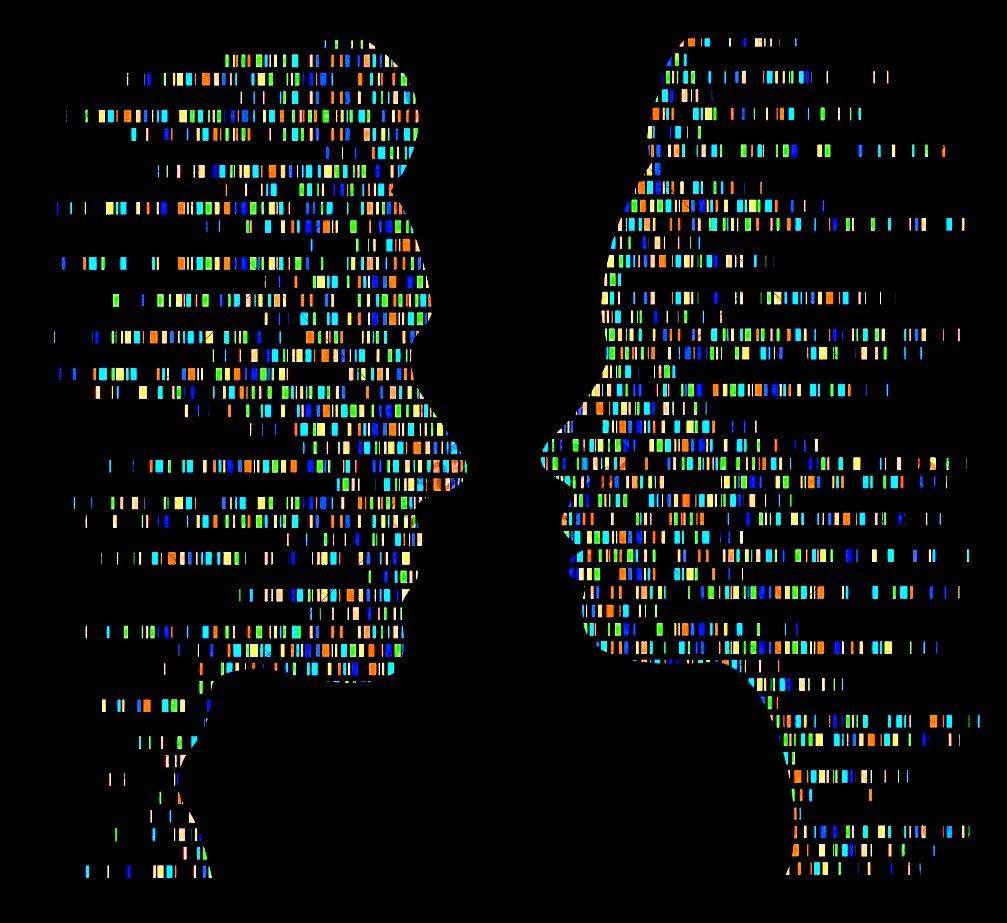
With a $2.1 million, five-year funding renewal from the National Institute of General Medical Sciences, Illinois Institute of Technology Associate Professor of Physics and Biology Jeff Wereszczynski and his team of graduate students and postdoctoral researchers are advancing their exploration of the role of biomolecules in genetic expression. The group, which specializes in computational biophysics, is utilizing supercomputers to run simulations of molecular dynamics, conducting research that could one day have implications for the treatment of many human disorders and diseases, including cardiovascular, autoimmune, and neurological disorders along with multiple forms of cancer.
“People typically think you are the result of what genes you have, but that’s only part of the story,” Wereszczynski says. “It’s not just the genes you have but how they get expressed. Epigenetics is the study of how gene expression occurs and how that’s controlled by factors outside and inside the body. One of the things my group is
interested in is the molecular mechanisms that control gene regulation. We [explore] this using large-scale supercomputers, and in collaboration with experimentalists using cutting-edge techniques.”
The team’s findings could one day inform the development of chemotherapeutic and other drugs that target specific genetic factors in individuals in personalized medicine.
“In the past we’ve looked at the smallest part of chromosomes, the nucleosome,” Wereszczynski says. “We’re now in a position where we can examine more complex systems, including how nucleosomes interact with both other nucleosomes and other proteins and molecules in the cell to understand how changes to proteins and DNA can affect large-scale gene expression.”
Research reported in this article was supported by the National Institute of General Medical Sciences (NIGMS) of the National Institutes of Health under award number R35GM119647.
—Linsey Maughan
10 Illinois Tech Research COMPUTATION AND DATA
Illinois Tech Research 2022
Double the Catalyst
Illinois Institute of Technology Assistant Professor of Chemical Engineering Mohammad Asadi has transformed the carbon dioxide capture process, allowing the gas to be removed from exhaust produced by various industrial processes and transformed into useful products such as ethanol. —Simon Morrow
1 The flue gas from many industrial processes contains excess carbon dioxide, one of the main greenhouse gases driving climate change.
2 Asadi’s process takes this exhaust gas as input into a combined carbon dioxide capture and conversion system.
3
Inside the system is an innovative co-catalyst, a material that combines cheap and highly available transition metals with an organic conductive polymer to both capture and convert the carbon dioxide in a single step, providing a much cheaper and simpler alternative to current processes that must do each step one-at-a-time. 4

The cell facilitates this process through a series of steps. First, the cell is filled with water, which gets broken down into hydrogen and oxygen using a common process at the anode.
5
The hydrogen is positively charged and drifts over to the cathode, where things start to get interesting. The double catalyst that makes up the cathode conducts two steps: First, it draws the carbon dioxide molecules in toward metal nanoparticles, which causes the carbon dioxide molecules to each stick to the nanoparticle surface, gain an electron, and become negative.
6 Adjacent carbon dioxide molecules then connect to each other by forming a carbon-carbon bond. Hydrogen atoms then bond to the new molecule. 7 The result is high-purity ethanol, a useful and valuable product with a billion-dollar market.
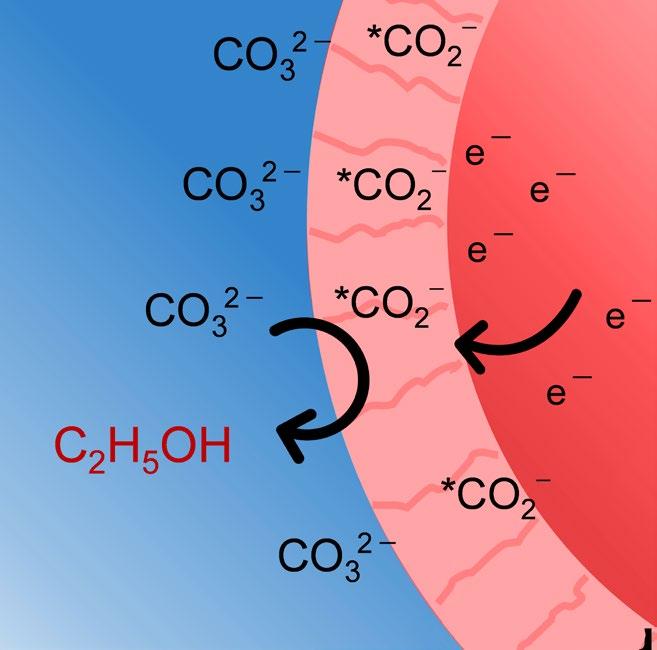
The overall process is almost half the cost of comparable methods for achieving this series of chemical reactions, resulting in a highly affordable way to transform a greenhouse gas into a useful product.
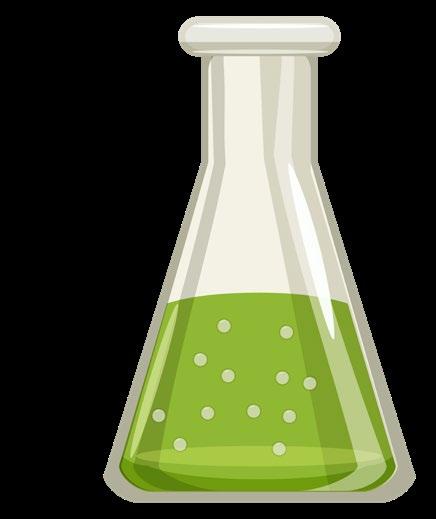
11 ENGINEERING
Water Outlet Water
Cathode Memberane Anode
Inlet
5 2 6 3 1 7 4
Catalyst Illustrations (center, right) courtesy of Mohammad Asadi
No Cancer Left Behind
During the operation, the surgeon can then switch off the lights and take a closer look at where the cancer is located.
imaging, which has been proven highly effective in Tichauer’s non-clinical studies, aims to take this a step further: It involves injecting the patient with a second fluorescent molecule that attaches to all cells—both healthy and cancerous— equally. 6 The surgeon can then compare the two fluorescent distributions in an area, getting an even more precise look at where the cancer is located.

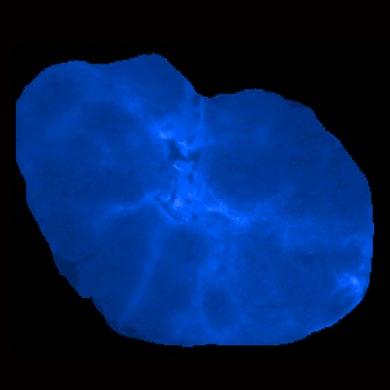






this improved view, the surgeon can potentially take out less tissue overall with a higher confidence that they removed all cancer cells.
Associate Professor of Biomedical Engineering Kenneth Tichauer’s paired-agent imaging technique gives surgeons a new way to see cancer cells. —Simon Morrow 1 To prevent cancer from coming back, it’s essential that all cancer cells get removed during surgery. Currently, surgeons often resort to removing extra tissue around a tumor to achieve this. Even still, sometimes the tumor gets clipped and a small portion gets left behind. 2 Paired-agent imaging takes the guesswork out of the equation by letting the surgeon see even small clusters of cancer cells, determining a more precise border. 3 This is done by injecting a patient with a fluorescent molecule that attaches to epidermal growth factor receptors. In adults, these receptors are much more prevalent in cancer cells than in healthy cells.
this improved view, the surgeon can potentially take out less tissue overall with a higher confidence that they removed all cancer cells.
12 Illinois Tech Research ENGINEERING
7
Illinois Tech Research 2022 5 2 6 3 1 7 Healthy Cell Healthy Cell Cancer Cell Untargeted Fluorescent Molecule Targeted Untargeted Paired-agent imaging Targeted Fluorescent Molecule Cell Illustrations Courtesy of Kenneth Tichauer Cancer Cell Blood Plasma Blood Plasma 4 Cell Illustrations:
4
5 Paired-agent
With
With
Shining Empirical Light on Big Tech Acquisition Activity
Are technology megafirms buying up small, innovative companies to squelch competition and maintain their market domination? Calls to rein in big tech are coming from lawmakers and regulators in the United States, the European Union, and countries around the world. But is this narrative accurate?
Liad Wagman, the John and Mae Calamos Dean Endowed Chair and professor of economics at Illinois Institute of Technology’s Stuart School of Business, has been conducting groundbreaking research that gathers empirical evidence to shed light on the effects of merger and acquisition (M&A) activity by the largest tech companies.
Wagman has an extensive research background in market competition, antitrust, innovation, and new venture financing, as well as experience as senior economic and technology adviser at the United States Federal Trade Commission’s Office of Policy Planning. In 2021 he led a major FTC study on the M&A activities of the group of companies referred to as GAFAM—Alphabet/Google, Apple, Facebook/Meta, Amazon, and Microsoft. While the study report made waves due to the sheer number of acquisitions by GAFAM that it reveals, he notes that the focus on just five firms gives an incomplete picture.
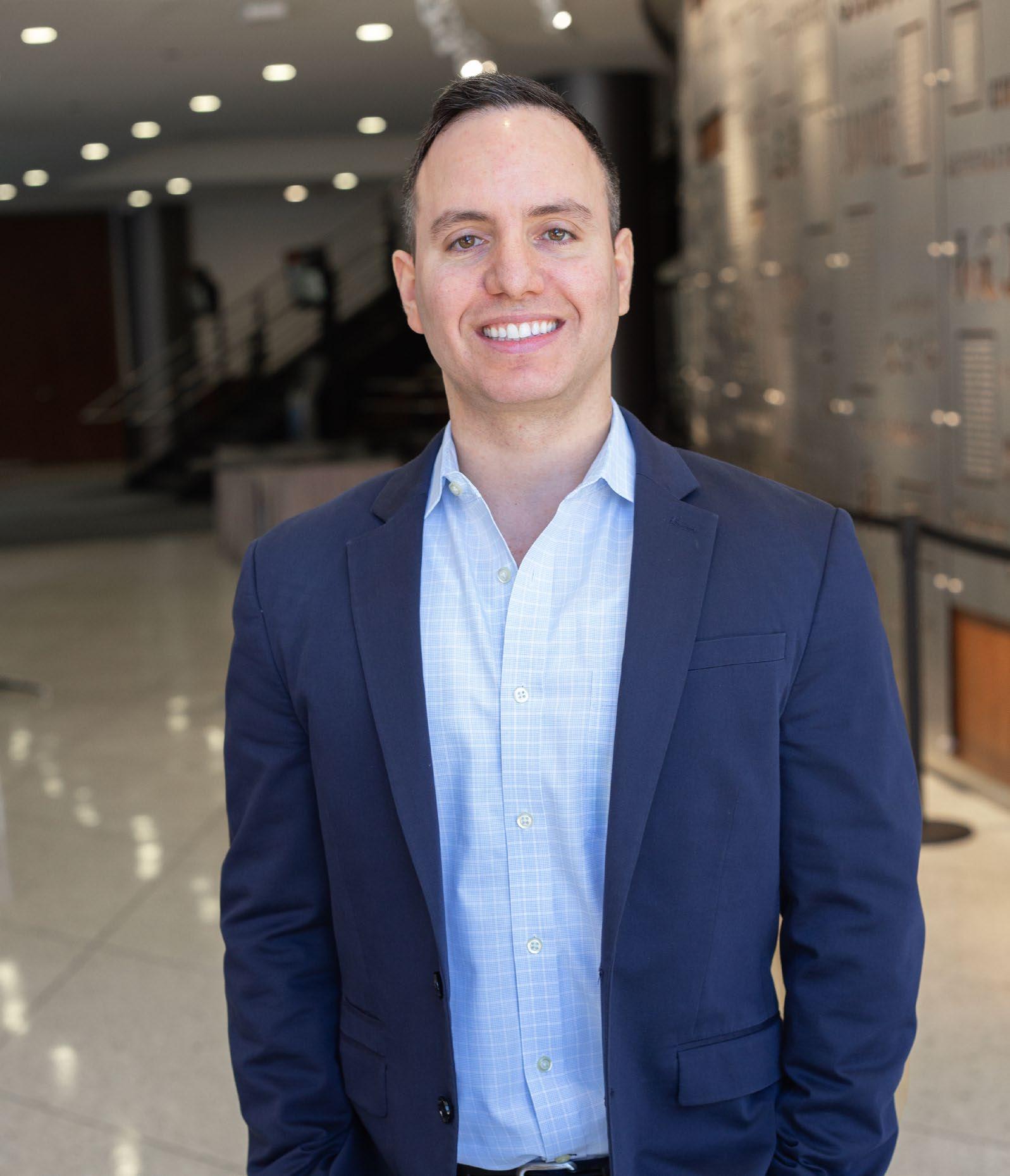
To more fully explore the tech M&A landscape, Wagman has undertaken projects with researchers from the University of Maryland—Ginger Zhe Jin, professor of economics and former director of the FTC Bureau of Economics, and Ph.D. candidate Mario Leccese—that leverage a unique combination of databases, taxonomies, and econometric methods to provide evidence that can inform policymakers.
Wagman’s work in the space is showcased in a series of papers, including “How Do Top Acquirers Compare in Technology Mergers? New Evidence from an S&P Taxonomy,” which has been published by the International Journal of Industrial Organization, “M&A and Technological Expansion,” which expands the analysis to the broader economy, as well as in a newer project entitled “Do Mega Firms’ Acquisitions Chill Startup Innovation? New Evidence from Technology Venture Investment,” which was recently presented at the 2022 Competition and Regulation European Summer School and Conference.
His research shows that GAFAM’s acquisitions in various technology sectors are not necessarily associated with reduced
competition, either within GAFAM or from other major players in tech M&A, such as Samsung, AT&T, Cisco, and Intel, nor do they necessarily hinder the entry of new startups into similar business and technology areas. In fact, competition within such areas and within GAFAM has been increasing over time.
Moreover, the findings indicate that businesses across all types of industries acquire tech companies in order to gain access to technology that can help them improve their products, maintain or expand their business, and remain profitable. “This [M&A activity] has the added benefit of bringing those innovations from smaller [tech] companies and entrepreneurs into the bigger market by commercializing them and making them
more widely available,” says Wagman.
Now the research team has embarked on their next project, “The Effect of Tech M&As on Innovation Incentives,” supported by a $75,000 grant from the Washington Center for Equitable Growth. They will examine the effect that the acquisition of startups has on innovation activity in the technology sector, which is a primary driver of economic growth. This is a key area for policymakers, according to Wagman and Jin, who argue that the debate on how to regulate large technology platforms, such as GAFAM, “is not productive until we answer a fundamental empirical question: Does incumbent acquisition of tech startups systematically foster or deter technological innovations? —Scott Lewis
13 ECONOMICS
“ M&A activity has the added benefit of bringing those innovations from smaller tech companies and entrepreneurs into the bigger market by commercializing them and making them more widely available.”
—Liad Wagman, John and Mae Calamos Dean Endowed Chair and Professor of Economics
NUTRITION, on DEMAND
 By Linsey Maughan
By Linsey Maughan
14 Illinois Tech Research
Britt Burton-Freeman
Illinois Institute of Technology is one of 14 centers collaborating on a new nationwide nutrition study that will gather more data on human responses to different dietary interventions than any other in history.
Researchers aim to combine biometric data collected from 10,000 individuals participating in this study with artificial intelligence and machine learning (ML) technologies to advance the development of personalized nutrition plans, or precision nutrition, a service that could eventually be made more widely available to health care practices.
The study, called the Nutrition for Precision Health (NPH) Program, is funded by the National Institutes of Health (NIH) and will build upon existing research available from NIH’s All of Us Research Program. NIH is awarding a combined total of $170 million to fund five years’ worth of research across the participating universities and research centers, which themselves are collaborating as smaller consortiums.
“This will be a landmark study of human variability in response to diet,” says Britt Burton-Freeman, a professor of food science and nutrition and the chair of the Department of Food Science and Nutrition, who is leading Illinois Tech’s involvement in the project.
“If we think about personalized medicine, this is personalized nutrition—providing the right diet for the right person at the right time,” Burton-Freeman says. “You can’t personalize [nutrition] if you don’t understand variation in humans. The data we collect across all centers will come from physical assessments and biospecimen collections so that genetics, gut microbes, and biological data can be combined with lifestyle, social, and environmental data to determine why people respond the way they do to different dietary regimens, and then use these data to develop algorithms that predict individual responses to foods and dietary patterns powered by ML.”
Illinois Tech is partnering with Northwestern University and the University of Chicago, and is receiving around $4.5 million to fund its own portion of the research over five years. The three universities together make up one of six clinical research centers across the country, and will be operating under a shared name, the Illinois Precision Nutrition Research (IPNR). The IPNR will be executing dietary interventions in the Chicago region with a combined total of $13 million in funding to carry out this research. The researchers are seeking as diverse a range of study participants as possible in terms of age, sex, race, genetics, geographic location, and more.
“Illinois Tech will be performing clinical research protocols in
one-third of the 2,000 study participants on Mies Campus in our Clinical Nutrition Research Center, a division of the university’s Center for Nutrition Research,” says Burton-Freeman.
There are three modules to the dietary interventions, Burton-Freeman says.
“One is to assess the acute dynamic responses to a test meal and the variability relative to people’s usual diets over two occasions,” she says. “The second module is to take that same meal, the test meal, and this time test individual responses to the meal after changing people’s usual background diet. We’ll do this three times with three different diets for two weeks. The three diets will differ compositionally but not calorically. We will give study participants all the specific foods and drinks we want them to consume daily and to maintain their current body weight. In the third module, we repeat module two except people live with us for two weeks. Throughout the experiments we are collecting blood, urine, saliva, and stool samples along with performing a variety of other assessments for analysis.”
By having a portion of study participants live in designated housing for two weeks in the third module, the researchers can more fully control their habits.
“Behavioral and to some degree environmental aspects will be assessed in the third module,” Burton-Freeman says. “An objective of this part of the research is to determine what and how much changes in our assessment readouts by fully controlling what people eat and do, versus having them in their normal environment living their regular life.”
Burton-Freeman says the first year of collaboration will involve planning the exact course of research that will be conducted, including the specific diets and meals as well as the biomarkers that will be assessed in participants. The remaining four years of the study will be spent executing the plan.
All of Us and Nutrition for Precision Health, powered by the All of Us Research Program, are service marks of the United States Department of Health and Human Services. The Illinois Institute of Technology is a performance site on the Northwestern University award, grant number UG1 HD107697-01.
MORE INFORMATION CONTACT
iit.edu/directory/people/ britt-burton-freeman
15
R
Britt Burton-Freeman Professor of Food Science and Nutrition Chair, Department of Food Science and Nutrition
Illinois Tech is partnering with Northwestern University and the University of Chicago, and is receiving around $4.5 million to fund its own portion of the NIH research over five years.
By Casey Moffitt
eveloping machine learning models that use massive data sets has proved useful in making short-term predictions, but current methods used to make long-term predictions of complex dynamic systems have fallen short.
Researchers from Illinois Institute of Technology have joined a team of scientists to develop stable surrogate models that will be able to make long-term predictions that could benefit research in areas like weather and climate change, or nuclear fusion energy sciences. Jinqiao “Jeffery” Duan, professor of applied mathematics, and Romit Maulik, research assistant professor of applied mathematics and assistant computational scientist at the Mathematics and Computer Science Division at Argonne National Laboratory, will receive $1.2 million of a $3.6 million grant from the United States Department of Energy that was awarded to the research team developing “Inertial Neural Surrogates for Stable Dynamical Prediction.”
“This project will lead us to advances in modeling, analyzing, and predicting dynamical behaviors of complex systems, with
new tools in machine learning and data science together with methods in stochastic dynamical systems,” Duan says. “Our research will enable greater confidence in the long term forecasting of crucial applications such as weather and climate dynamics with reduced computational costs.”
Long-Term Predictions, D
“Recently, large quantities of data are being generated by really large simulations and observations from things like satellites and experiments,” Maulik says. “We want to use machine learning to leverage these data sets for surrogate [models] that are as accurate and as stable as possible.”
Maulik explains that the current surrogate models are primarily designed for short-term predictions. However, when the techniques used for short-term predictions are leveraged to make long-term predictions, the models tend to “explode,” or generate results that defy the laws and principles of physics.
“We know that long-term predictions using state-of-the-art methods fail, but this project will study why they do so and design strategies to prevent that,” Maulik says. “We want to leverage our understanding of certain systems to build better methods that do not explode or converge to unphysical solutions.”
The research team will be trying to discover underlying “structure” in data using novel methods, and then use that structure to
16 Illinois Tech Research 16
Hold the ‘Explosions’
prevent nonsensical solutions in the long run.
Duan will be leading investigations into the construction of surrogate models for stochastic dynamical systems, leaning on his years of experience in stochastic dynamics research. Maulik brings his expertise in state-of-the-art machine learning, as well as his engagement with Argonne and relevant applications such as weather and climate forecasting.
They join Prasanna Balaprakash and Hong Zhang of Argonne, Joshua Burby and Qi Tang of Los Alamos National Laboratory, and Ioannis Kevrekidis of Johns Hopkins University on the project.
The project is one of five that the DOE is supporting with a $16 million investment in its Data-Intensive Scientific Machine Learning Research and Analysis initiative. Each project focuses on developing reliable and efficient artificial intelligence and machine learning methods for a broad range of scientific needs, including potential applications in areas such as forecasting power grid behavior, predicting extreme weather events, and high-energy physics and cosmology. “Data-Intensive Scientific Machine Learning and Analysis” is sponsored by the Office of Advanced Scientific Computing Research (ASCR) within DOE’s Office of Science. R
“This report was prepared as an account of work sponsored by an agency of the United States Government. Neither the United States Government nor any agency thereof, nor any of their employees, makes any warranty, express or implied, or assumes any legal liability or responsibility for the accuracy, completeness, or usefulness of any information, apparatus, product, or process disclosed, or represents that its use would not infringe privately owned rights. Reference herein to any specific commercial product, process, or service by trade name, trademark, manufacturer, or otherwise does not necessarily constitute or imply its endorsement, recommendation, or favoring by the United States Government or any agency thereof. The views and opinions of authors expressed herein do not necessarily state or reflect those of the United States Government or any agency thereof.”
MORE INFORMATION CONTACT
Jinqiao “Jeffrey” Duan Professor of Applied Mathematics iit.edu/directory/people/ jinqiao-duan
Research Assistant Professor of Applied Mathematics iit.edu/directory/people/ romit-maulik
17
“ We know that long-term predictions using state-of-the-art methods fail, but this project will study why they do so.”
—Romit Maulik, Research Assistant Professor
Romit Maulik
Maurice Dawson
S ECURITY, FROM THE START
By Casey Moffitt

Technology is just part of the problem when it comes to building strong cybersecurity solutions in developing countries.
Maurice Dawson, assistant professor of information technology and management at Illinois Institute of Technology, found that out firsthand. Dawson allocated his fourth United Statees Fulbright Scholar award to conduct research and deliver lectures at Botswana International University of Science and Technology—all in pursuit of exploring cybersecurity issues in developing countries and how they can have a global impact.

He discovered that cultural issues complicated technical cybersecurity issues.
“The people of Botswana are very trusting,” Dawson says. “It’s a country of 2.4 million people, and everybody seems to know everybody.”
Botswana is surrounded by neighboring countries with corrupt governments, political instability, and scammers who operate freely, Dawson says, and it is closely connected to its neighbors. For example, Botswana works closely with South Africa for some of its infrastructure needs and Zimbabwe to supplement its labor force.
18 Illinois Tech Research 18
This combination of a trusting culture and close ties with its neighbors can make for a challenging cybersecurity environment.
“When you’re sharing resources with your neighbors, it opens new vulnerabilities,” Dawson says. “You expect your neighbor to be secure, but that’s not always the case.”
There are elements in place to improve cybersecurity in Botswana, Dawson says. The tech infrastructure has been modernized, which allows the implementation of cybersecurity measures.
“Having that central infrastructure is a big deal, so we can have the cybersecurity mechanisms in place,” Dawson says. “Now they have to start thinking about attacks. Throughout most of the country, they just don’t think about it.”
Part of Dawson’s work included examining cybersecurity issues associated with the possibility of using drones that the Botswana Defence Force uses to deter poaching. Botswana is home to the Central Kalahari Game Reserve, the Moremi Game Reserve, and a network of national parks that cover nearly a fifth or more of the country’s land mass. This vast wilderness attracts poachers from neighboring countries.
“The Botswana Defence Force relies on outdated methods to look for poachers from Namibia, Zambia, Zimbabwe, and South Africa,” Dawson explains. “We looked at how drones could include other internet-enabled technologies and ensure that cybersecurity can be used to secure the data these drones are collecting.”

Dawson teamed up with Oteng Tabona and Thabiso Maupong of Botswana International University of Science and Technology to edit a cybersecurity book, Cybersecurity Capabilities in Developing Countries and Its Impact on Global Society. The book, Dawson’s fourth on the subject of cybersecurity, is a collection of research and case studies that examine the security of mobile devices, databases, system networks, and the Internet of Things as developing nations make rapid advances in technological progress.
“We knew we had time to work on editing the book, so we contacted researchers from South Africa to make contributions,” Dawson says. “All these nations are thinking about the Internet of Things, cryptocurrency, and artificial intelligence. So they need to think about security as well.”
The book covers the techniques, laws, and training initiatives being implemented and adapted for secure computing and is designed as a reference source for researchers, university academics, computing professionals, and upper-level students.
The book also explores how cybersecurity issues in these developing nations can have a global effect.
“It looks at how a credit scam in South Africa can affect me in Singapore,” Dawson says. “Everything is intertwined.”
Dawson wrote a chapter of the book, “East African Cybersecurity: Improving Microfinance Database in Ethiopia.” His collaborators on the chapter include Damon Walker, a teaching professor of information systems and technology at the University of Missouri-St. Louis, and Tenace Setor, assistant professor of information systems and quantitative analysis at the University of Nebraska Omaha. He also recruited two recent Illinois Tech alumni, Andreas Vassilakos (ITM, M.A.S. CYF ’21) and Harshini Chellasmy (ITM, M.A.S. CYF ’22), to make contributions.
The research highlights how Kenya has become an East African leader in using information communications technology (ICT), specifically in mobile payments and health care. Other East African nations, such as Ethiopia, have seen how this technology has impacted Kenyan society and are increasingly trying to replicate those efforts.
In Ethiopia, many farmers rely on ICT to secure financing to cover the costs of land leases, materials purchases, and labor. Dawson says the highly authoritarian government has made security issues more difficult as they have outlawed security measures such as Voice over Internet Protocol (VoIP). However, the significant undermining of the use of cryptography leaves micro-financing databases vulnerable.
“Many times, farmers apply for a loan, and that information gets lost,” Dawson says. “In many cases, the information is stored on USB drives, and someone drives them to another location to process the loan. It’s not uncommon for those USB drives to get lost.”
Dawson says the research team looked at open-source solutions that could be effectively installed into these databases and USB drives to make them more secure. Dawson says the costs of securing these assets are a big concern, which is why the team focuses efforts on open source solutions.
To further provide insight into the connectedness of cybersecurity, Dawson held the Positive Uses of Technology and Science Scientific Workshop in Tunisia in July 2022. This conference had participants from L’Institut Supérieur des Etudes Technologiques en Communications de Tunis, Nigeria, Saint Louis University, Capital Technology University, Botswana International University of Science and Technology, and others. He aims to hold this conference back in West Africa and Nigeria in the summer of 2023.
Dawson says he hopes his experience at Botswana International University of Science and Technology can lead to further research collaboration and the possibility of student exchanges. He says he is encouraged as some researchers he met during his time at Botswana participated in ChiCyberCon, a cybersecurity conference held on Illinois Tech’s campus, in April 2022. R
MORE INFORMATION CONTACT
Dawson Assistant Professor of Information Technology and Management
iit.edu/directory/people/ maurice-dawson
19
“ When you’re sharing resources with your neighbors, it opens new vulnerabilities... You expect your neighbor to be secure, but that’s not always the case.”
—Maurice Dawson, Assistant Professor
Maurice
Arlen Moller
KEEP YOUR
By Linsey Maughan
Global Study Reveals the Psychology Behind Effective Social Distancing Messages
A
massive, global study of social distancing motivations has yielded new, psychology-based insights into the effectiveness of different styles of social distancing messaging.
Illinois Institute of Technology associate professors of psychology Nikki Legate and Arlen Moller, in collaboration with co-lead coauthor Thuy-vy T. Nguyen, an assistant professor of psychology at Durham University, found that messages that encouraged personal agency were more likely to influence individuals’ behaviors than those that were controlling or shaming.
Though the study began early into the pandemic, Moller says its findings may continue to prove helpful going forward.
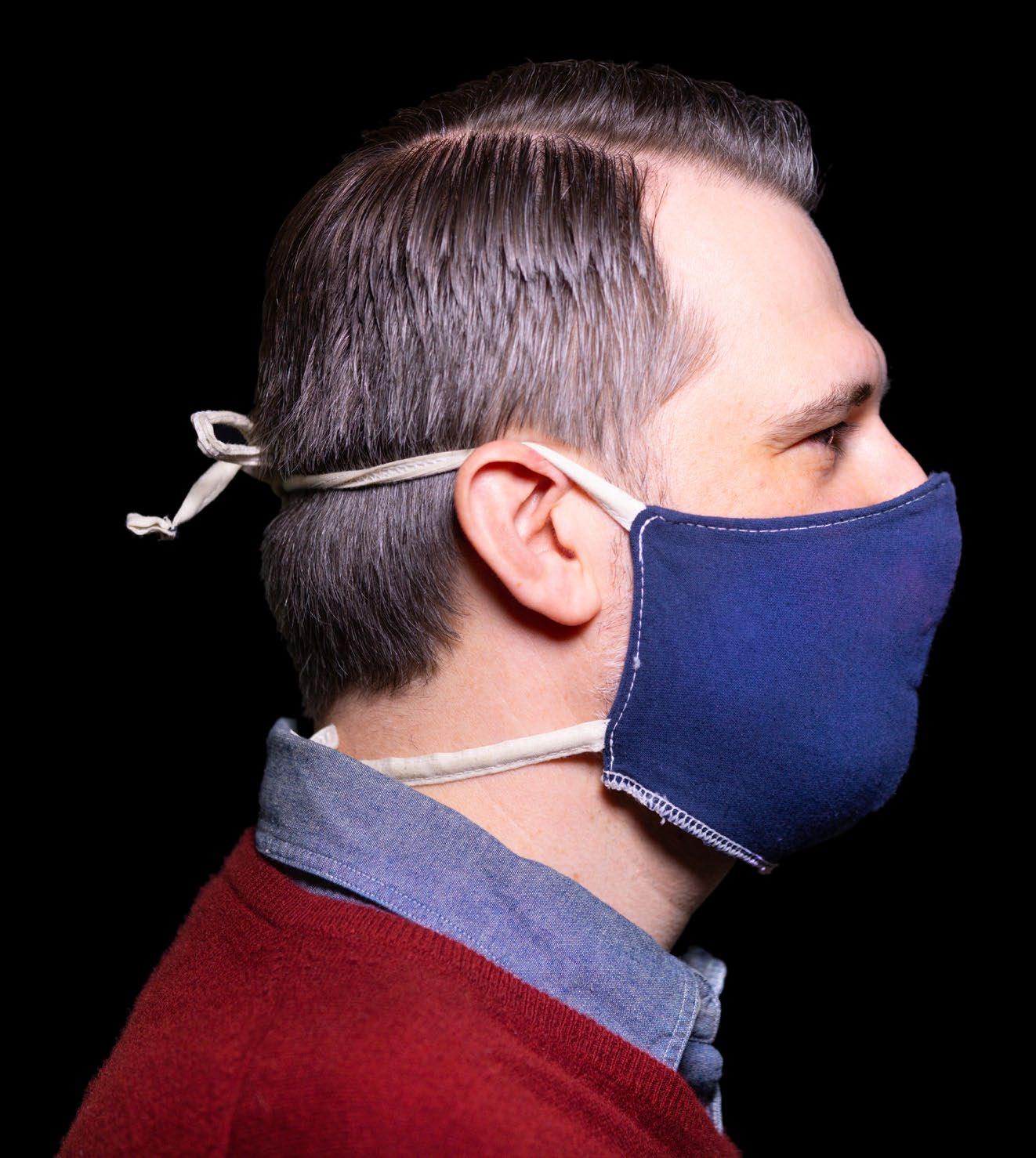
20 Illinois Tech Research 20
“As pandemic fatigue sets in, many people across the globe are considering abandoning risk-mitigating behaviors, while some even go out of their ways to defy them, despite threats of death and long-COVID to self and others, and rising case rates in many places,” he says.

The study was launched in response to a 2020 call for projects from the Psychological Science Accelerator, a democratic network of labs around the world, to use psychological science to help solve global problems related to COVID-19.
“The mission of this project [was] to find universally effective ways of motivating people to engage in social distancing around the world, and to see whether there are unintended costs of using common motivational strategies like shaming and pressuring people,” Legate says.
The researchers engaged 27,190 study participants from 89 countries, and collected data from April to September 2020.
“There haven’t been that many projects that have involved coordinating team science in this way,” Moller says. “I think it’s at the very edges of advancing how psychological science is done.”
The team’s paper, titled “A Global Experiment on Motivating Social Distancing During the COVID-19 Pandemic,” was published in May in the Proceedings of the National Academy of Sciences, a peer-reviewed journal of the National Academy of Sciences. It was also presented at the Society of Behavioral Medicine’s Annual Meeting in April. More than 500 collaborators from around the world served as reviewers and coauthors on the paper.
DISTANCE?
“It’s a pandemic that is affecting every corner of the world,” Legate says. “It was very important to us to really know, if our messages were effective, were they effective globally? We’re interested in finding solutions that can apply all over the world, not just in specific subsets. We’re trying to figure out solutions for a global population, so the fact that we observed a few small generalizable effects is exciting.”
Study participants were randomly assigned one of three conditions: an autonomy-supportive message that inspired reflective choices, a controlling message about social distancing that was forceful and shaming, or no message at all. They read a short passage that was an appeal to engage in social distancing, and then took a one-time survey in response.
“The messages were pretty identical except for some key words—blaming and shaming versus those that promoted agency and personal choice,” Legate says. “What we found is that these messages that we’re calling autonomy supportive— messages that encourage choice and personal agency around social distancing—had some benefits compared to messages that were controlling, really shaming, or making people feel like a terrible person if they don’t do it.”
For example, participants reading an autonomy-supportive message experienced lower feelings of defiance, compared with those reading a message that was controlling or shaming. Moller cites news coverage of “COVID parties” during the pandemic—
instances where people showed up for large social gatherings despite government recommendations to stay home and socially distance, or to socialize in small groups only—as an example of defiance. He also says the study’s findings mirrored those of other studies around human behavior and motivational messaging.
“The correlational findings were almost entirely as predicted in terms of defiance and long-term intentions,” Moller says. “There is a lot of behavioral medicine research that follows similar patterns to what we observed here—to exercise, take your medicine, etc. But I don’t think any study on motivating health behavior has been as large and diverse as this one.”
The data set from this project is available to any researchers interested in conducting follow-up studies.
“The insights from the first stage of analyzing these data were about global messaging campaign strategies,” Moller says.
“Follow-up research could look at the many different dimensions that cultures vary on. Researchers who are interested in one or multiple aspects of culture can now go deeper to see, with more nuance, if in a particular culture, one messaging strategy was more or less effective. We hope to continue developing this research to help control COVID and future pandemics.” R
MORE INFORMATION CONTACT
Arlen Moller
Associate Professors of Psychology
iit.edu/directory/people/ arlen-moller
Associate Professors of Psychology iit.edu/directory/people/ nicole-legate
21
Nikki Legate
The researchers engaged 27,190 study participants from 89 countries.
Nikki Legate
LEGAL -EASE
By Tad Vezner
How good of a lawyer should an artificial intelligence system be? More importantly, how good do you want one to be?
When it comes to teaching machines how to understand and utilize language, it turns out that the more legalese that they know, the better, according to a new paper co-authored by Chicago-Kent College of Law Professor and Law Lab Director Daniel Martin Katz.
“It is pretty clear that a legally trained AI system is just going to perform better—but the open question is to identify the precise information diet to feed these models” Katz states simply.
His paper, “LexGLUE: A Benchmark Dataset for Legal Language Understanding in English,” explores how different large language models (LLMs) were used to solve a variety of tasks.
Pioneered by organizations such as Google, OpenAI, and the Allen Institute, LLMs have grown increasingly popular in the field of natural language processing. Many LLMs have been trained on general language but the question that Katz and his colleagues sought to explore is how to apply these LLMs to legal tasks. They analyzed several of the different models to evaluate the performance of LLMs on tasks such as evaluating contracts, including determining if such contracts were unfair under European Union consumer law.
“A lot of effort in computer science goes into making machines understand language broadly,” Katz says. “How do

you train a machine in the language of law? Well, how do you train a person? You send them [to law school] for three years, and you say a lot of words at them. You use words in a variety of contexts. In a real sense, you are training a student’s neural network (their brains).”
That’s what the models tested in Katz’s paper did: They exposed machines to a large corpus of different words, and measured how effective those words were at getting the machines to solve tasks.
It turned out, of the seven different models that were tested, the model that taught legal language got the machines, on average, to perform tasks better—not just legal tasks, but any type of task.
“The diet of getting legal information when it’s being trained makes it better across all tasks,” Katz says.
The paper was deemed intriguing enough to be accepted for presentation at the Association for Computational Linguistics annual 2022 meeting in May 2022. R
MORE INFORMATION CONTACT
Daniel Martin Katz Chicago-Kent College of Law Professor Law Lab Director
kentlaw.iit.edu/law/facultyscholarship/faculty-directory/ daniel-martin-katz

22 Illinois Tech Research
Daniel Martin Katz
22
MIRAGE, OR HIDDEN OASIS?
By Linsey Maughan
Hao Huang
Several Chicago South Side neighborhoods depend on the limited healthy food options available in convenience stores, and when there are few stores open, local obesity rates go up, a new study from Illinois Institute of Technology shows.
The neighborhoods are predominantly African American and have the lowest access to food options in the city while having the highest obesity rates in Chicago, says Assistant Professor of Social Sciences Hao Huang.
Huang published her new findings on the relationship between racial segregation, food deserts, and obesity in the city this summer in a paper titled “A Spatial Analysis of Obesity: Interaction of Urban Food Environments and Racial Segregation in Chicago.” The article appears in the Journal of Urban Health.
“When looking at Chicago, the obesity rate in Chicago has increased to more than 30 percent in the last two decades,” Huang says. “Obesity is a major problem in Chicago, where 36 percent of the city’s high school students and 61 percent of adults in the metropolitan area are overweight or obese. Simultaneously, Chicago remains highly segregated by race—a phenomenon that begs for spatial analysis of health.”
Huang’s research took place in 2020, beginning with a literature review looking at connections between food environments, race, and obesity. After further neighborhood research, she developed models to assess how these three elements interact.
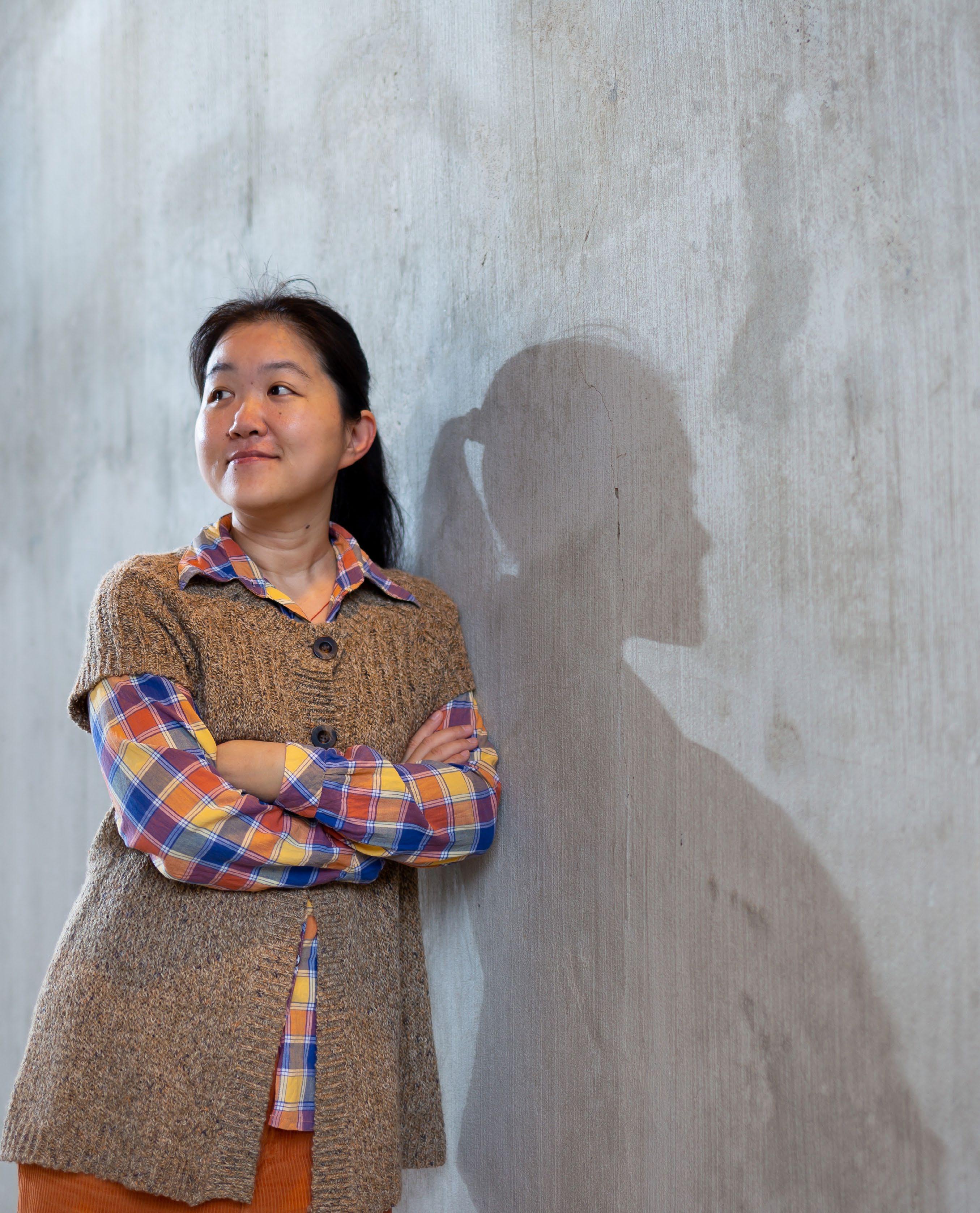
“Fifty-seven communities have [below average] access to supermarkets. Twenty-six out of these communities are African-American communities, so African-American communities account for 46 percent of communities with the number of supermarkets below the average—much higher than their population share [of] 29 percent,” Huang says.

One surprising factor in Huang’s findings was the role of convenience stores, which work to the advantage of South Side neighborhoods that have fast-food options but few grocery stores. The opposite is true on the North Side of the city, which has an abundance of grocery stores. Convenience stores there contribute to an increase, rather than a decrease, in obesity rates.
“Convenience stores are the key food environment influence on [the availability of healthy foods] in household food supplies among limited-resource communities, such as African-American communities in the South Side of Chicago,” Huang says.
Huang says her findings could be helpful to urban planners considering where new grocery stores should be built. From a health perspective, the South Side of Chicago would benefit most from the addition of more grocery stores and convenience stores and fewer fast-food options, whereas the North Side would benefit from fewer convenience stores being built. R
MORE INFORMATION CONTACT
Hao Huang
Assistant Professor of Social Sciences
iit.edu/directory/people/ hao-huang

24 Illinois Tech Research
Seok Hoon Hong
THE SECRET WEAPON IN THE FIGHT AGAINST BACTERIA
By Simon Morrow H
ealing a wound is a matter of waging war: as bacteria congregate and multiply on the wound surface, preventing healing and causing infections, doctors can apply an army of antibiotics and antimicrobials to try to kill the bacteria.
Gut bacteria are evasive. They’ve adapted their behaviors to be resistant to these attacks, leaving some patients suffering from chronic and even life-threatening infections with no available treatment.
Chronic infections affect 2 million United States residents annually and cause 200,000 deaths, and the annual cost of treatment is in excess of $18 billion.
Now Seok Hoon Hong, associate professor in Illinois Institute of Technology’s Department of Chemical and Biological Engineering, has engineered a “spy,” armed with a new weapon, that he hopes to use to infiltrate the bacterial ranks.
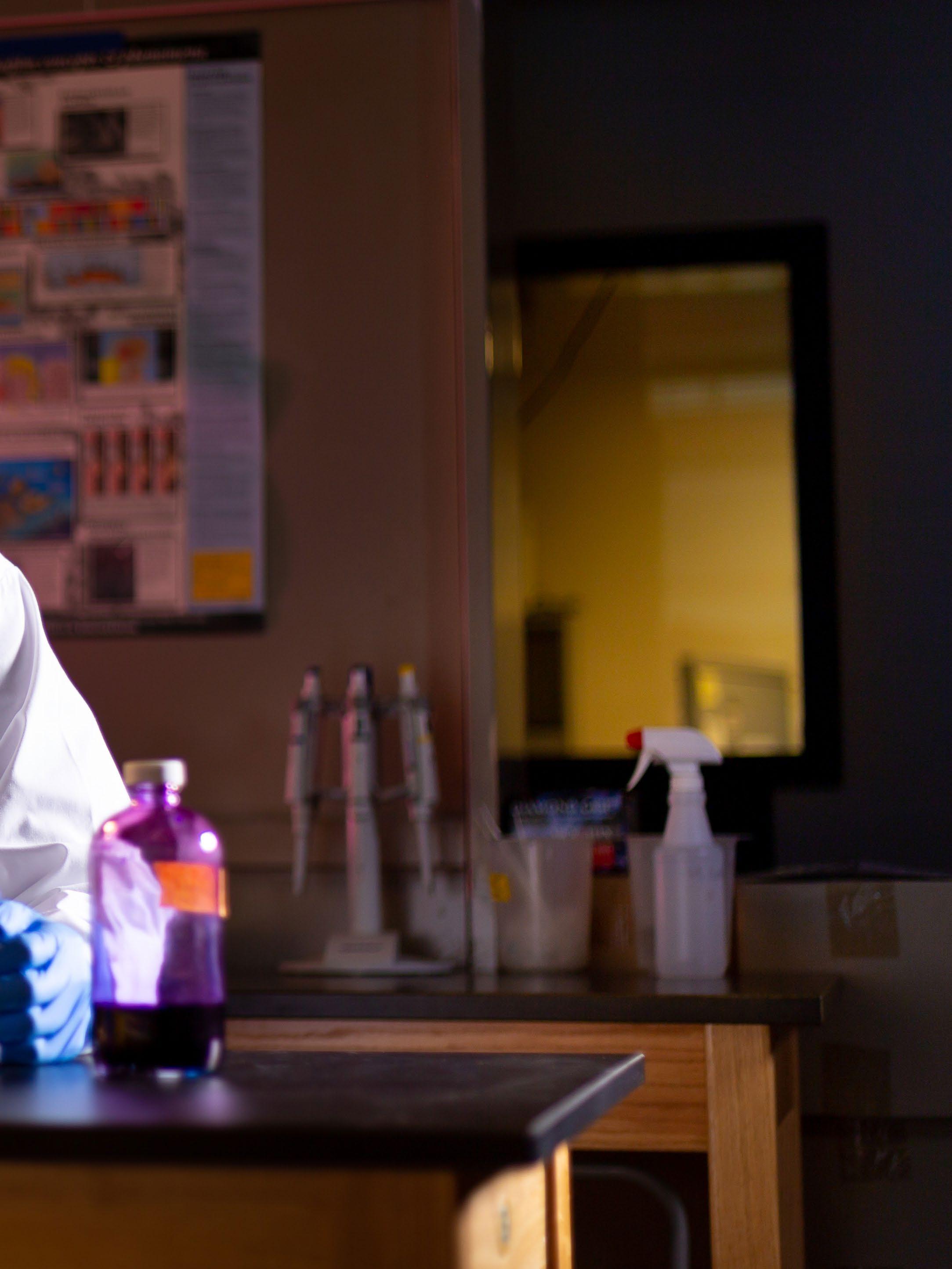
25
The most resistant bacteria are those that gather into a safe community. Gathering bacteria can secrete a sticky material that keeps them glued to each other and the wound while also providing defense by making it harder for antibiotics to get inside. This is known as a biofilm, and it has been identified in up to 80 percent of chronic infections.
But the most dangerous adaptation of the bacteria cuts right to the heart of how antibiotics function.
“The majority of conventional antibiotics inhibit bacterial growth. However, inside a biofilm, instead of continuing to grow, the bacteria can go to sleep. Such dormant cells are called persisters,” says Hong, who has multiple ongoing biofilm-related projects funded by the National Institutes of Health and the National Science Foundation. “Without growing, antibiotics cannot kill the bacteria. Then later, once the antibiotic levels decrease, the bacteria can grow again. If cells don’t form the biofilms, they are easily killed by conventional antibiotics, but I want to kill those non-growing, or the sleeping, bacteria.”
Hong recognized that the best solution to this problem would be twofold: It needs a new weapon to kill the bacteria even when they are dormant, and it needs to be able to work its way into the biofilm to get access to all the bacteria.
To find his weapon, Hong considered the range of bacteria-killing options beyond conventional antibacterials, and when he came across bacteriocins, a type of antimicrobial protein, he realized he had found the perfect candidate.

While generally not as good at killing bacteria as antibiotics, the mechanism that bacteriocins utilize to kill bacteria means that they can get around bacterial defenses: Instead of relying
on cell growth, bacteriocins bash open the cell membrane or degrade the genetic material of the bacteria—awake or asleep.
Plus, bacteriocins have the added advantage of being targeted, meaning their design determines which kind of bacteria they can kill. This means that by design they will only go after the targeted pathogenic bacteria while leaving good cells alone, meaning there is no collateral damage.
With a new weapon in hand, Hong still had to figure out how to get the bacteriocins into the biofilm. For this, he came up with the idea to engineer a spy that could integrate into the bacterial community just to turn around and pump out bacteriocins, eradicating the infection-causing bacteria.
The spy? Escherichia coli, more commonly known as E.coli, a bacterium infamous for causing food poisoning but one that has become an invaluable chassis for genetic engineers who have found they can modify the bacteria to suit their own purposes.
“Then, engineered E.coli and the pathogenic bacteria can mix and form the biofilm together. However, while the biofilm grows, the E.coli can produce and secrete the antimicrobial protein and effectively kill the pathogenic biofilm bacteria,” says Hong.
In September 2021 Hong’s paper showing proof of concept results of this idea was selected for publication in the Futures Issue of the AIChE Journal, an annual issue that highlights “pioneering early career research.”
As described in the paper, Hong turned E.coli into bacteriocin factories capable of wreaking carnage on biofilms.
To do this, he needed to give the E.coli a set of instructions for how to create the bacteriocin proteins. He also needed to set up a control circuit that would allow him to tell the E.coli when to produce the proteins.
All of those instructions needed to be written in a language that the E.coli could interpret: the language of genetic code.
26 Illinois Tech Research Ecoli
26 Chronic infections affect 2 million United States residents annually, cause 200K deaths, and annually cost in excess of $18 billion for treatment
‘‘I
n principle, if you design a genetic circuit based on the knowledge you get from a textbook, the genetic circuit should work,” says Hong. “But in many cases, the circuit doesn’t work well, and we don’t know the reason exactly why. Sometimes we need to go back and change the actual DNA sequence. Sometimes we need to change the genetic parts of the DNA. So it requires some optimization, but in the end, we found circuits that are working well for our experiment.”
With the genetic modifications in place, Hong could see that when he triggered the genetic circuit by sending the E.coli a chemical signal, it was able to make the bacteria-killing proteins, but those proteins were still mostly trapped inside the E.coli.
So Hong developed a second genetic circuit that, when triggered by a second chemical signal, would spew those proteins out into the biofilm and decimate the target bacteria.
The whole process took a lot of experimentation.
“In our initial trials, it was very difficult to find out what concentration of chemical signals to turn on the protein production and to turn on the protein secretion,” says Hong. “If the protein production is very high, sometimes it’s a burden to the cell growth. So, we wanted to find the condition to make the cells grow well and healthy while producing the antimicrobial proteins. Optimizing the chemical concentration was challenging.”
For this proof of concept, Hong engineered his E.coli to make a type of bacteriocins called colicin that would selectively kill a second strain of E.coli cells with a target receptor while leaving all other cells in the biofilm alone.
In the end, Hong produced results that show the modified E.coli can cause significant damage to a biofilm by eliminating almost all of it under conditions where conventional antibiotics would be unlikely to do any damage.

“We showed our engineered E.coli producing the antimicrobial protein is very effective to inhibit or to kill the target biofilms,” says Hong.
Now that he has shown the idea works, Hong has been working on creating new versions of the E.coli that can produce novel bacteriocins that target common antibacterial-resistant infections. He already has preliminary results targeting Pseudomonas aeruginosa, a well-known bacterium that can cause a range of blood, lung, and other infections. More than 60 percent of adults with cystic fibrosis suffer from Pseudomonas infections.
He also has plans to target Staphylococcus aureus, the bacterium behind staph infections, which is capable of causing sepsis, pneumonia, heart failure, and more.
It’s the kind of high-impact work Hong has become known for in the field, as recognized by the United States chapter of the Korean Institute of Chemical Engineers (KIChE), which honored him with the 2020 KIChE President Young Investigator Award for his research and exceptional potential for leadership in the field. He also was recognized by the Industrial and Engineering Chemistry (I&EC) Research journal as I&EC Research’s 2021 Class of Influential Researchers.
Because bacteriocins kill bacteria in a target-specific manner without collateral damage to nearby healthy cells, they are expected to work well in environments such as the digestive tract, where there is a mixture of helpful and harmful bacteria and a need to develop a treatment that kills only the harmful ones.
While so far Hong has focused on health-related biofilms, he says this technique may also be applied to kill just about any bacteria.
Just as in wound healing, there are potential applications such as cleaning products or waste treatment plants where the goal is to eliminate harmful bacteria. There is also a range of bio-industrial processes that rely on growing and controlling bacteria such as fermentation or biofuel production where this technique could become a new tool used to make those processes more efficient.
Ultimately, this is a technique that Hong sees as working in conjunction with conventional antibiotics.
“In the situations where antibiotics work, they are very effective, but this gives us a way to intervene when antibiotics are not working,” says Hong. R
Disclaimer: “Research reported in this publication was supported by the National Institute of Allergy and Infectious Diseases, part of the National Institute of Health, under Award Number R15AI130988.”
Seok Hoon Hong, “Engineering Colicins to Control Antibiotic Tolerant Bacteria,” National Institute of Allergy and Infectious Diseases; Award Number R15AI130988
MORE INFORMATION CONTACT
Seok Hoon Hong Associate Professor Department of Chemical and Biological Engineering
iit.edu/directory/people/ seok-hoon-hong
27
“ We showed our engineered E.coli producing the antimicrobial protein is very effective to inhibit or to kill the target biofilms.”
—Seok Hoon Hong, Associate Professor
A Sensor (able) Approach to Sustainability
 By Simon Morrow
By Simon Morrow
28 Illinois Tech Research
Carrie Hall
Behind the glitz of electric cars is a transportation sustainability problem yet to be solved: large vehicles like long-haul trucks and airplanes are still challenging to electrify.
Illinois Institute of Technology Associate
Professor of Mechanical and Aerospace Engineering Carrie Hall says alternative fuels may be a viable solution, but it’s not as simple as topping up existing engines with the latest biofuel. Engines are designed with a specific fuel—usually gasoline or diesel—in mind.
Hall has created a new computer model that can help enable diesel engines to run on a different fuel with just a software update.
“Since we are focusing on a software upgrade, somebody can actually put that into their vehicle without incurring a lot of extra costs,” she says. “They’re not really going to have to change the hardware on their vehicle.”
As a first step she has applied it as a possible intermediate solution for trucks moving away from diesel.
“There’s an anticipation that with electric vehicles being more common for passenger cars in the United States that there’ll be a lot of extra gasoline that’s not getting used. That gasoline can be used on heavier-duty vehicles. That’s a strategy that’s still being explored,” says Hall. “Making engines smart enough to use a broader range of fuels also opens the door to other possibilities, such as using carbon-neutral or carbon-negative fuels.”
For heavy-duty trucks, which account for more than a quarter of United States on-road vehicle energy consumption despite representing only 1 percent of on-road vehicles, improving efficiency is key.
“Everything that we’re doing is looking at trying to get to cleaner and more efficient vehicles,” says Hall.
She says that the one big obstacle to running a diesel engine on gasoline is the difference in reactivity.
Gasoline fuel injected into an engine cylinder normally won’t burn until the engine provides a spark to start the fire, and then the resultant explosion will travel uniformly away from the spark through the engine cylinder.
On the other hand, diesel tends to spontaneously combust after it is compressed in the cylinder. When you try to run gasoline in a traditional diesel engine, the cylinder explosion may be unpredictable, or it might not burn at all.
The timing is essential as engine efficiency depends on running multiple cylinders in harmony.
“If fuel burns a little too early or too late, you don’t actually get all the benefit from it, and the efficiency is worse,” says Hall.
To understand how to get the most out of burning gasoline, diesel engines need real-time information on when the fuel has ignited.
“Things that are actually happening inside the engine cylinder are really hard to measure in a cheap way,” says Hall. “So what we’re trying to do is take the information that we get from simpler, inexpensive sensors that are outside of the actual engine cylinder where the combustion is happening, and from that diagnose what’s happening inside the engine.” If this was just any model, Hall could do detailed multidimensional fluid dynamics calculations. The catch is that in order for it to be a model that’s useful to engine operation it needs to run in real time, anticipating the time of ignition up to thousands of times each minute.
“Our models are used to provide some system feedback,” says Hall. “Understanding the timing of [fuel ignition] gives us an idea
of how it was tied to something like fuel injection, which we then might want to adjust based on that feedback.”
Some engine control designers achieve speed in their model by utilizing machine learning techniques or storing large data tables to avoid model calculations, but Hall has taken a different approach.
“We’ve been trying to create models that are based on the underlying physics and chemistry, even when we have these very complicated processes,” she says. “Recently there’s been interest in using neural networks to model combustion. The problem is that then it’s just a black box, and you don’t really understand what’s happening underneath it, which is challenging for control, because if you’re wrong, you can have something that goes very wrong.”
So instead, Hall began with the complicated version of the calculations and explored ways to simplify them until she found ways to describe the science with equations that were faster to solve, while still achieving the industry standard of accuracy for control models.
“We’ve tried to capture all the underlying effects, even if it’s in a more detailed way than we know we’re going to really be able to use for real-time control, and let that be our reference point. Then we simplify it down by using things like neural networks strategically, but we keep this overall structure so that we understand what each piece means and what it’s actually doing inside there,” says Hall.
The result is a more adaptable model. While a pure machine learning approach needs to be completely retrained for each new fuel, Hall can simply update some parameters that correspond to measurable fuel properties.
This is key to Hall’s research, which explores a range of fuel options. She has done work on novel fuel ideas, such as fuel blends, and she is a member of a collaborative group that was recently awarded $2 million by the U.S. Department of Energy to test novel applications of a low-carbon fuel called dimethyl ether.
Hall’s control model, which Illinois Tech Research Assistant Professor Michael Pamminger (Ph.D. MAE ’21) worked on as a student in Hall’s research group, is one piece of a larger project to figure out how to use gasoline in diesel engines and was conducted in collaboration with Argonne National Laboratory, Navistar, and Caterpillar.
“We’re working with those companies to try to help them understand the underlying combustion processes, but then also to build tools that they can potentially fold into their own software, and then enable their next generation of engines to use these fuels and use them well,” says Hall. R
Disclaimer: “Research reported in this publication was supported by the National Science Foundation under Award Number 1553823. This content is solely the responsibility of the authors and does not necessarily represent the official views of the National Science Foundation.”
Carrie Hall, “CAREER: Control of Advanced Fuel-Flexible Multi-Cylinder Engines,” National Science Foundation; Award Number 1553823
MORE INFORMATION CONTACT
Carrie Hall Associate Professor of Mechanical and Aerospace Engineering
iit.edu/directory/people/ carrie-hall
29
Attacking the Problem
 By Linsey Maughan
By Linsey Maughan
30 Illinois Tech Research
Oscar Juárez
New research from Illinois Institute of Technology Associate Professor of Biology Oscar Juárez and a team of multi-institutional and multidisciplinary colleagues aims to develop new oral antibiotics for the treatment of cholera, certain sexually transmitted infections, and other infectious diseases. Juárez has been awarded a four-year, $2.2 million grant from the National Institutes of Health’s National Institute for Allergy and Infectious Diseases to fund the research.
Many of today’s antibiotics are no longer well suited to treat cholera, Juárez says. The disease is often fatal, especially in children.
“It turns out that many antibiotics are becoming obsolete,” Juárez says. “Many bacteria are no longer susceptible to any antibiotics. We desperately need new treatments, so what we decided to do is use all of the background info we have obtained to develop novel drugs that can be used by clinicians. The drugs will be tested on human cells and mitochondria, then will be tested in preclinical trials.”
Vibrio cholerae, the bacteria that cause cholera, live in rivers, lakes, and oceans, and a person becomes sick after eating or drinking something contaminated with the bacteria. Cholera cases frequently arise in the wake of disasters, and cholera outbreaks are ongoing in Africa and South Asia.
“The NIH sees the problem,” Juárez says. “The drugs we are obtaining are active and of high medical relevance. It is possible that we can obtain a broad-spectrum drug that can be used against certain STIs and hospital-acquired infections. In a single campaign we can obtain a drug that can be used against many different infectious diseases.”
Joining Juárez in this research are Research Assistant Professor of Biology Karina Tuz, who will be conducting toxicity tests, molecular biology, and cellular biology experiments; Robert E. Frey Jr. Endowed Chair in Chemistry and Associate Professor of Chemistry David Minh, who will run computer simulations pertinent to the project; Daniel Becker, a professor focused on medicinal chemistry at Loyola University Chicago; and Jerzy Osipiuk, a protein crystallographer at Argonne National Laboratory.
The researchers have already identified one specific enzyme, NQR, that is found in human pathogenic bacteria and plays a critical role in the pathogenesis of cholera and other diseases. Juárez and his colleagues plan to target NQR with the drugs they develop.
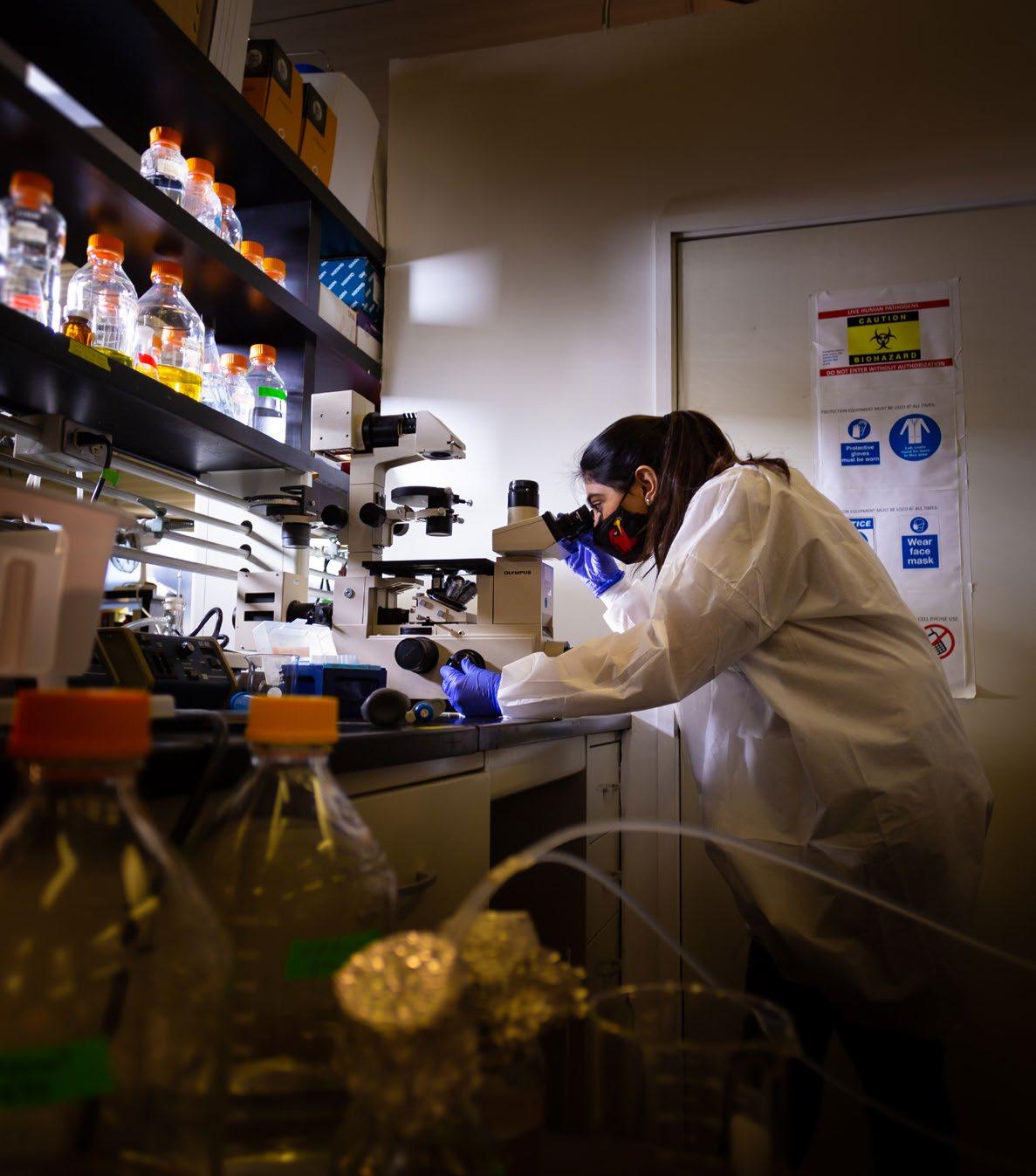
“By understanding the enzyme’s structure, we can produce novel antibiotics,” Juárez says. “We have already found two novel classes of chemicals that can be turned into antibiotics, targeting the protein that we’re working on. In the next step of our drug ,
development strategy, we will optimize the potency and toxicity profile of these inhibitors. We expect that it will take us two or three years to increase the effectivity before we can test them in animal models.”
Juárez has been studying pathogenic bacteria since joining Illinois Tech, and he aims to understand how these organisms survive in the human body.
“We’re putting a lot of effort into understanding how this bacterium work and what are the metabolic steps we need to target, using a rational approach to develop antibiotics,” Juárez says. “We decided to use all of the information we have collected at the protein and cell levels, to predict what are the best treatments. We have a completely novel idea and strategy that has not been prescribed before as antibiotics. This allows us to contribute to bridge the growing gap in antibiotic treatment, using translational biomedical research that could really be helpful in the clinic.”
Juárez says that, in November 2022, the group has developed a drug with no toxicity that can eliminate cholera in vitro, and preliminary studies show that it is highly effective in animal models. R
Research reported in this article was supported by the National Institutes of Health National Institute for Allergy and Infectious Diseases under award number 1R01AI151152-01A1.
MORE INFORMATION CONTACT
Oscar Juárez
iit.edu/directory/people/ oscar-juarez
31
Associate Professor of Biology
“ It turns out that many antibiotics are becoming obsolete.”
—Oscar Juárez, Associate Professor of Biology
By Scott Lewis

URF D SYSTEM TRANSF RMING
32 Illinois Tech Research
Weslynne Ashton
In the United States, it’s estimated that up to 40 percent of the food produced is never eaten, while 10 percent of Americans are food insecure. Food is being wasted at every step of the food supply chain that connects farms to forks—from production to distribution to stores, restaurants, and consumers.
It doesn’t have to be that way, says Illinois Institute of Technology Associate Professor Weslynne Ashton, a sustainable systems scientist who holds dual appointments at the university’s Stuart School of Business and Institute of Design (ID). Currently, her practice and teaching includes projects on the local and national levels—two of which are supported by the National Science Foundation and that are focused on increasing equity, sustainability, and resilience in urban food systems. The projects are tied together by a vision of the circular economy in which there is greater circulation of resources—food, as well as money, knowledge, and social capital—that can strengthen communities and mitigate climate impacts.
She’s part of a network of researchers aiming to change the status quo and find ways to reduce wasted food nationally, supported by $15 million in NSF funding over a five-year span. The project, Multiscale Resilient, Equitable, and Circular Innovations with Partnership and Education Synergies (RECIPES) for Sustainable Food Systems, brings together more than 40 researchers at 14 universities and institutions across the country, led by American University. The RECIPES team includes experts drawn from environmental science, engineering, economics, anthropology, design, and other fields.
“The goal of this project is to transform what we know and what we do about wasted food,” Ashton says. “We’ll look closely at how food waste is being generated, find opportunities to minimize the waste, and optimize solutions that reuse or recycle those wasted resources as much as possible. Then there’s implementation—how do we put solutions into practice?”
“Current efforts to address this challenge have varied from very grassroots and community-oriented, to local government initiatives, to private investment and industry coalitions,” she notes. “With RECIPES, we’re trying to pull information together from multiple sources nationally and investigate how to use that data for more comprehensive solutions.”
For example, one line of inquiry being pursued by Ashton and some other project members is to explore options for using food that is inedible. “We’re looking at anaerobic digestion, composting, and converting that organic material into land improvement or into biogas,” she says. “So we’re considering the technology and the markets for biogas and other types of material.”
In Chicago, Ashton has begun with a landscape assessment to identify key players in local efforts to address wasted food, such as the Wasted Food Action Alliance, and to understand the existing ways that food is being collected, repurposed, renewed, and reinvented in communities across the city.
According to Ashton, building partnerships with people, businesses, and organizations that work directly in all aspects of the food supply chain is crucial to the project’s success.
“Insights about approaches that have worked in different places can be shared [with people elsewhere] to replicate and adapt in their communities,” she says. “We’re building up a body
of generalizable knowledge about [how to develop] solutions to wasted food and making sure that research is communicated to stakeholders who can use it.”
Ashton and Illinois Tech are the only RECIPES partners in the Chicago area, and the project leverages and amplifies Ashton’s longstanding, community-based engagement through both her research and teaching with food systems and the circular economy locally, including, for example, efforts to develop urban agriculture, food waste, and energy hubs.
Ashton serves as co-leader of ID’s Food Systems Action Lab, where students are using design and other disciplines—such as business, sustainability, and engineering—to develop new approaches and tools that can help communities envision and build more equitable, effective, and sustainable food systems. In the spring 2022 semester, her project-based courses at both Stuart and ID provided opportunities for students to learn about and co-develop social enterprise and wasted food solutions with Chicago-based community partners.
Illinois Tech students in business and design have been involved in Ashton’s work with RECIPES, as well as with the Community Food Mobilization in Chicago (CFMOB) project, for which she recently received a $50,000 Civic Innovation Challenge planning grant from the NSF.
Led by Ashton, CFMOB is a group of community organizations, civic partners, and academic researchers that is exploring pathways for urban Black, Indigenous, and people of color farmers and other small, local food producers in the Chicago x region to self-determine their participation in the city’s foodshed, including becoming suppliers to large, institutional buyers of food such as Chicago Public Schools.
“Our overall thrust [at CFMOB] is to make the food system reflect the people who are part of it,” says Ashton. “That means what kinds of food are produced, including culturally affirming foods, how and where food is produced, how people are involved—as entrepreneurs, workers in the food chain, as buyers and eaters—and what is done with wasted food.”
With the planning grant, CFMOB is eligible to compete in early 2023 for the next phase of CIVIC—a $1 million implementation grant to support a year-long pilot project by the group in Chicago that could serve as a model for communities elsewhere. R
Disclaimer: “Research reported in this publication was supported by the National Science Foundation’s Division of Computer and Network Systems through the Smart & Connected Communities program under Award Number 2228645. This content is solely the responsibility of the author and does not necessarily represent the official views of the National Science Foundation.”
Weslynne Ashton, “Community Food Mobilization in Chicago,” National Science Foundation; Award Number 2228645
MORE INFORMATION CONTACT
Weslynne Ashton Associate Professor Stuart School of Business and Institute of Design (ID)
iit.edu/directory/people/ weslynne-ashton
33
According to the American Diabetes Association, 7.3 million adults in the United States have diabetes but are undiagnosed. Researchers from Illinois Institute of Technology have joined a team that is developing new techniques to identify individuals who are unaware that they may be living with the disease.
USING AI TO DIAGNOSE DIABETES
By Casey Moffitt
A seed grant from Discovery Partners Institute, a technology and innovation center led by the University of Illinois System, is helping the team build techniques and algorithms using artificial intelligence, multivariate statistics, and engineering that will help spot potentially undiagnosed diabetics. The goal is to produce a scalable system prototype that allows medical professionals to harvest electronic health records data and identify people with Type 2 diabetes, to select successful treatments for each patient, and to explain why the algorithm made the determination to the patients.
Kai Shu, Gladwin Development Chair Assistant Professor of Computer Science at Illinois Tech, is a co-investigator of the project and will be leveraging advanced AI and machine learning techniques to invent fair, explainable, and robust frameworks.

“I am curious about how techniques and algorithms based on artificial intelligence, multivariate statistics, and systems engineering can better help medical facilities in the detection of Type 2 diabetes,” Shu says.
Other Illinois Tech researchers on the team include Ali Cinar, the Hysoung S.R. Cho Endowed Chair, professor of chemical engineering, and director of the Engineering Center for Diabetes Research and Education, as well as Mudassir Rashid, research assistant professor of chemical and biological engineering. The team is led by Dr. Brian T. Layden, chief of the Division of Endocrinology, Diabetes, and Metabolism at University of Illinois Chicago’s College of Medicine.
Shu says, “[The partnership] enables us to apply a simulator for simulation-based science and digital twins in health care, and novel machine learning and explainable AI systems to address the needs of health care.”
The project will use electronic health records of UI Health patients. Machine learning and AI techniques and algorithms will build models of Type 2 diabetes patients using historical records of those diagnosed with the disease. Through data shaping, processing electronic health records data, and clustering patients into groups with similar characteristics, these techniques should be able to predict the disease in new patients, determine the most successful interventions, and build simulators to observe the effects of these interventions.
A simulator using patients’ digital twins—virtual agents created to simulate the features and co-morbidities of actual patients—will enable a personalized case study for specific patients with Type 2 diabetes and provide additional assistance to medical care providers selecting personalized treatment R
MORE INFORMATION CONTACT
Kai Shu Gladwin Development Chair Assistant Professor of Computer Science
iit.edu/directory/people/ kai-shu
34 Illinois Tech Research
34
Office of Research 10 West 35th Street
Michael Paul Galvin Tower, Seventh Floor Chicago, IL 60616

 Illinois Tech faculty, students, and staff are addressing a variety of societal needs.
Illinois Tech faculty, students, and staff are addressing a variety of societal needs.




























 By Linsey Maughan
By Linsey Maughan













 By Simon Morrow
By Simon Morrow
 By Linsey Maughan
By Linsey Maughan







